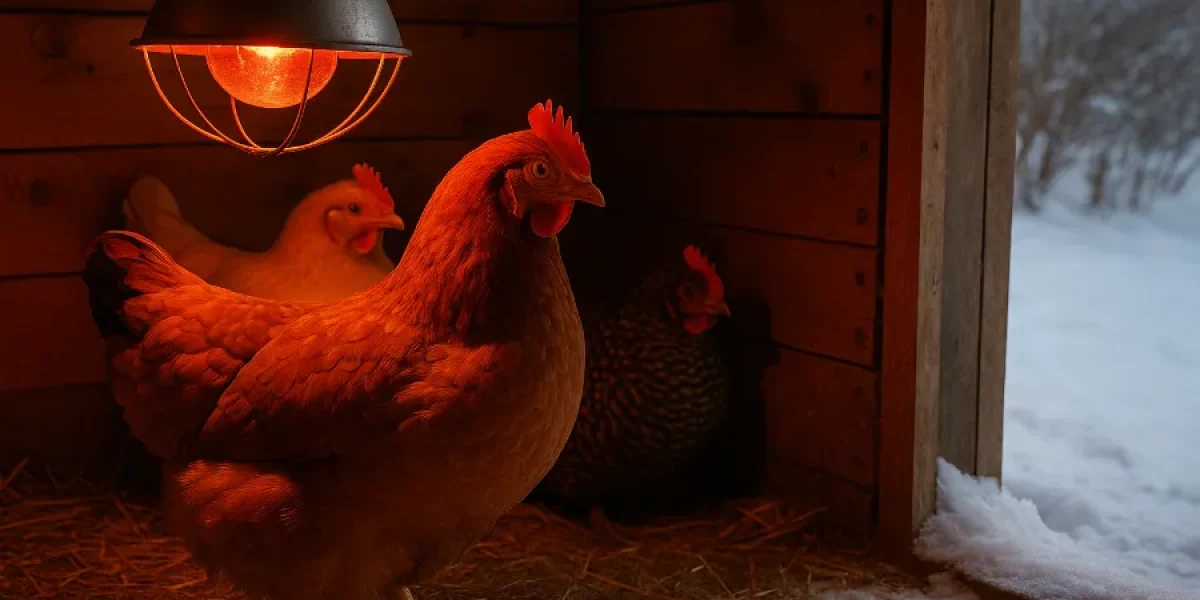Every fall, as the air turns crisp and my morning chores start with a layer of frost on the buckets, I begin my annual ritual figuring out how to winterize a chicken coop.
If you keep backyard hens, you’ve probably wondered the same thing: how do you make sure your flock stays warm, dry, and safe through winter without turning your coop into a stuffy sauna or a fire hazard? After years of trial and error, I’ve learned that a cozy winter coop is all about balance—keeping air moving but drafts out, trapping warmth without trapping moisture, and using what nature already provides.
Let me walk you through exactly how I winterize my coop each year, using methods that work for any setup—big or small, old or new, fancy or farmhouse simple.
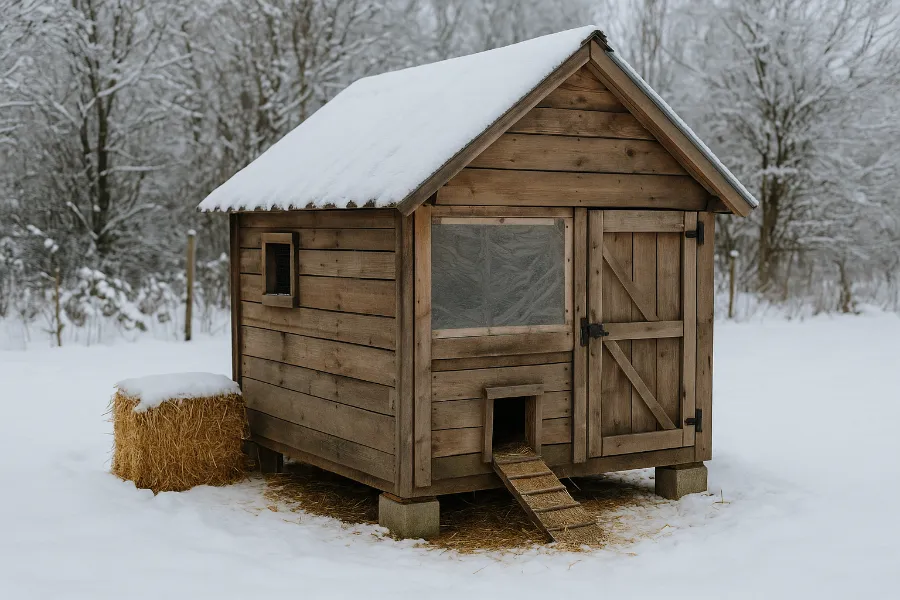
Deep Litter Method Chicken Coop
If you ask me, the deep litter method is a winter lifesaver—and maybe the best-kept secret of old-time chicken keepers. Instead of cleaning your coop every week, you let bedding and droppings build up over the season. The material composts slowly, creating natural warmth from the microbial activity below.
I start in early fall with a thick base layer of pine shavings, about four inches deep. Each week, I sprinkle fresh shavings or chopped straw on top to absorb moisture and odor. By midwinter, that bedding might be a foot thick—and surprisingly warm to the touch.
When done right, the deep litter method chicken coop acts like a low-tech heater. It keeps the air dry, gives hens soft footing, and saves me from constant cleaning. Come spring, I shovel it out, and what’s left becomes black gold for my garden.
Tip: Keep the litter dry and turned occasionally with a pitchfork. If it smells like ammonia, add more carbon-rich bedding and stir. You want slow composting, not soggy muck.
Winter Chicken Coop Ideas
Over the years, I’ve tried just about every trick for keeping the cold out. Some of these winter chicken coop ideas came from old farming manuals, others from my own experiments.
- Add straw bales around the base of your coop to act as windbreaks.
- Hang clear plastic sheeting or install plexiglass panels on the north side to stop drafts while still letting in sunlight.
- Create an entry “mudroom.” If your coop allows, build a small double-door vestibule so warm air doesn’t rush out when you open the door.
- Install roof vents or gable vents. Proper ventilation is non-negotiable in winter—moisture, not cold, causes frostbite.
- Paint your coop a dark color. Dark paint absorbs sunlight, raising inside temps naturally.
- Add roost curtains made from burlap or old feed bags to keep hens out of direct drafts at night.
Each fall, I spend a weekend checking for leaks, replacing weather stripping, and patching any holes where light (and therefore wind) can sneak through. It’s simple work, but it’s what keeps my flock comfortable through months of icy mornings.
Draft Free Chicken Coop
I used to think “draft-free” meant sealing up every crack tight. Big mistake. One winter, I over-insulated and closed off all vents—and by mid-January, my coop reeked of ammonia. The humidity had nowhere to go, and the moisture nearly gave one of my hens frostbite on her comb.
A truly draft free chicken coop isn’t airtight—it’s strategically ventilated. You want gentle airflow that carries out moisture but doesn’t blow directly across your roosting hens.
Here’s what works:
- Seal any holes near floor level or around doors where cold air can rush in.
- Keep vents high up, just under the eaves or along the ridge line.
- Make sure roosts are higher than vents to avoid cold air hitting your flock.
- Use smoke or incense to check for drafts—it’s a quick way to see where air is moving.
Now, my coop stays fresh, dry, and a few degrees warmer simply because it breathes right.
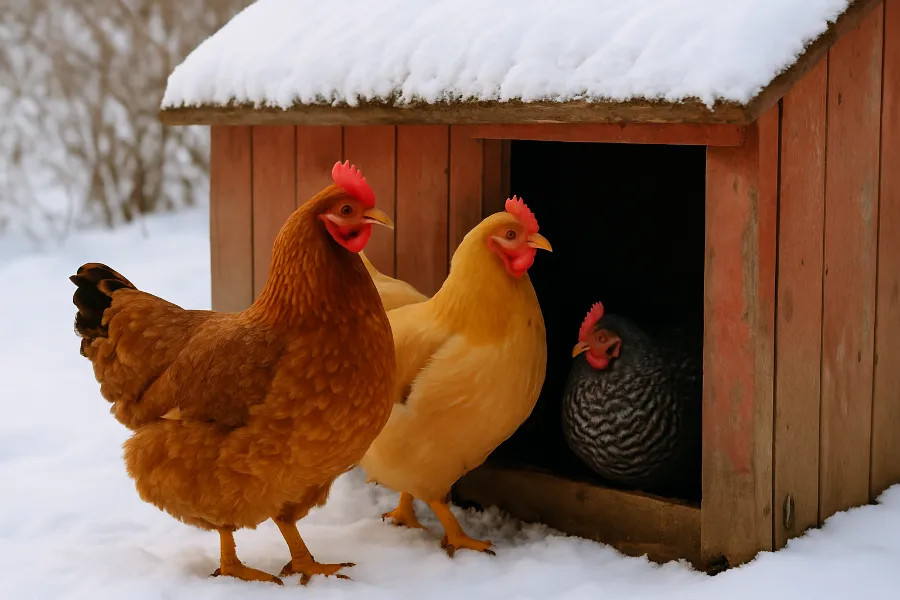
Cold Hardy Chicken Breeds
Some chickens handle winter like pros, while others shiver at the first frost. If you live where snow piles high, start with cold hardy chicken breeds. They have small combs, dense feathers, and calm temperaments that conserve energy.
My favorite winter-hardy breeds include:
- Buff Orpingtons: Feathered like walking quilts and endlessly gentle.
- Plymouth Rocks: Dual-purpose birds that keep laying even when it’s cold.
- Wyandottes: Rose combs and round bodies make them frostbite-resistant.
- Australorps: Shiny black feathers that soak up sunlight beautifully.
- Rhode Island Reds: Tough as nails and dependable layers all year.
If you’re just getting started, investing in these breeds makes wintering a lot easier. They’ll fluff their feathers, huddle together, and ride out the season like seasoned pros.
How to Prevent Frostbite in Chickens
Frostbite is something every chicken keeper dreads. It happens when moisture condenses on combs or wattles and then freezes. Fortunately, it’s completely preventable.
Here’s my cold-weather checklist for how to prevent frostbite in chickens:
- Ventilation first: Moisture rises, so make sure it can escape through high vents.
- Water outside the coop: No matter what, don’t keep waterers inside—it just adds humidity.
- Dry bedding: Always. Damp litter leads straight to frostbite.
- Wide roosts: I use 2×4 boards with the flat side up so hens can sit on their feet, protecting toes.
- Comb balm: A light coat of coconut oil or petroleum jelly on combs before an arctic blast keeps frost at bay.
When I check the coop at night and see my hens puffed up on the roosts, I know they’re cozy, dry, and safe.
Solar-Heated Chicken Coop
If you’ve ever walked into your coop on a sunny winter day and felt it warmer inside than out, you’ve already discovered the power of a solar-heated chicken coop.
I built mine with south-facing windows and a few clever tricks I picked up from greenhouse design. You can do this, too—even in an older coop.
My Favorite Solar Upgrades
- South-facing windows: Let the sunlight pour in during the day.
- Thermal mass: Line one wall with bricks or dark concrete blocks—they absorb heat and release it slowly overnight.
- Double-pane windows or storm panels: Keep heat from escaping too quickly.
- Reflective surfaces: Paint the interior a light color so the sunlight bounces around.
These changes won’t make the coop tropical, but they’ll raise the temperature several degrees—enough to matter on a bitter night.
Off Grid Homesteading
Learning to care for chickens without electricity taught me a lot about off grid homesteading in general. Winter is when those values—resourcefulness, sustainability, and self-reliance—really shine.
I rely on natural heat from composting litter, insulation from straw bales, and solar warmth. No cords, no lamps, no risk of fire. When you winterize this way, you’re not just keeping chickens—you’re embracing an old-fashioned, sustainable rhythm that connects you to the land.
The beauty of off-grid living is that it proves how little you actually need once you work with nature, not against it.
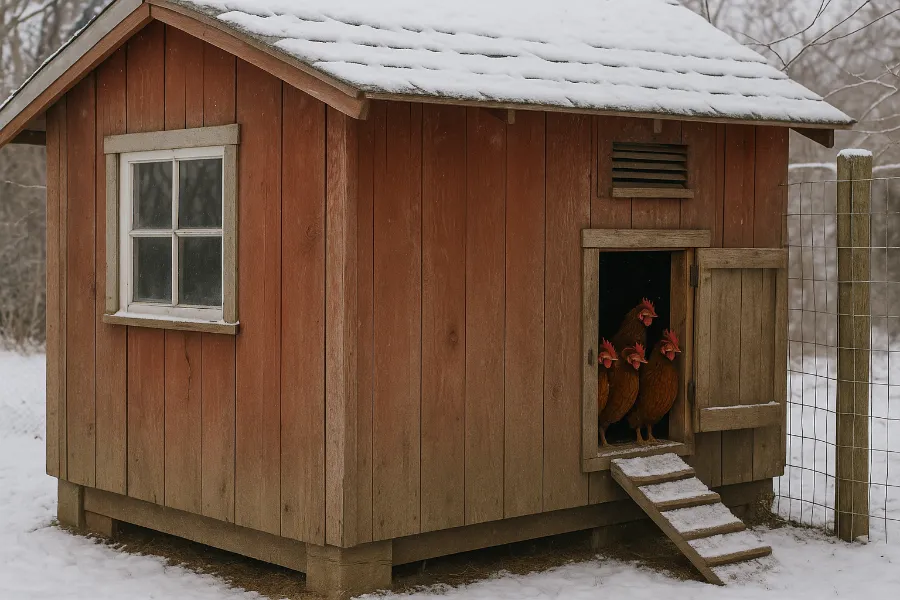
How Cold Is Too Cold for Chickens
I’ve been asked this question more than any other: how cold is too cold for chickens?
The truth is, adult chickens are far tougher than most people realize. With a dry, draft-free coop, most breeds can handle temperatures down to 15°F (-9°C) or even colder without heat.
What they can’t handle is dampness. Wet feathers destroy insulation, and humidity leads to frostbite. That’s why I focus less on the thermometer and more on the air quality inside my coop. If it’s dry, odor-free, and ventilated, I know my hens will be just fine.
Do Chickens Need Heat in Winter
Short answer: No.
Long answer: Only if you’ve built the wrong coop.
If you’re wondering, “Do chickens need heat in winter?” the answer depends on your setup. A properly winterized coop—one that’s dry, insulated, and ventilated—doesn’t need artificial heat. Chickens naturally fluff their feathers to trap warm air, and they generate body heat when roosting together.
Adding a heat lamp can actually make things worse. If power fails suddenly, the temperature shock can harm your flock. Plus, heat lamps are a major fire risk. Instead, let nature do its work—feed high-energy treats like cracked corn at dusk, and your hens will stay toasty all night.
Raising Hens for Eggs in Winter
Egg production naturally slows down in winter as daylight fades, but with the right setup, you can still collect a steady handful of eggs through the cold months.
My approach to raising hens for eggs in winter focuses on comfort and consistency:
- Plenty of light: A south-facing window is often enough.
- Warm nesting boxes: Line them with thick straw or shredded paper.
- Good nutrition: Add extra protein like mealworms or sunflower seeds.
- Stress-free environment: A calm, secure coop helps maintain laying cycles.
- Collect eggs early: They’ll freeze fast in low temps.
Some of my best winter layers are my oldest girls—proof that comfort and care matter more than artificial lighting or fancy supplements.
Predator Proof Chicken Coop
Winter brings its own predators. When the nights get long and food is scarce, raccoons, foxes, and even rats become bolder. A predator proof chicken coop is essential year-round, but especially now.
Here’s how I lock mine down each fall:
- Reinforce all openings with ½-inch hardware cloth—chicken wire isn’t enough.
- Bury fencing 12 inches deep to stop diggers.
- Add heavy-duty latches—raccoons can open simple hooks.
- Install a secure coop door or automatic door timer if you have power.
- Keep feed in sealed metal bins—rodents love cracked corn as much as hens do.
Nothing ruins a peaceful winter morning like finding tracks in the snow leading to a broken latch. Check everything before the first frost—your future self will thank you.
What Is the Deep Litter Method for Chickens
Since this topic deserves its own spotlight, let’s revisit it.
If you’ve ever wondered what is the deep litter method for chickens, think of it as the compost pile that keeps on giving.
You start with clean bedding, layer over droppings, add more bedding, and let nature handle the rest. The slow decomposition releases heat, creating a cozy floor that feels almost alive. It also breeds beneficial microbes that suppress pathogens—a natural sanitation system right under your hens’ feet.
By spring, you’ll shovel out a rich, earthy mix ready for your garden. No waste, no smell, no freezing toes. It’s one of the oldest and smartest homestead hacks there is.
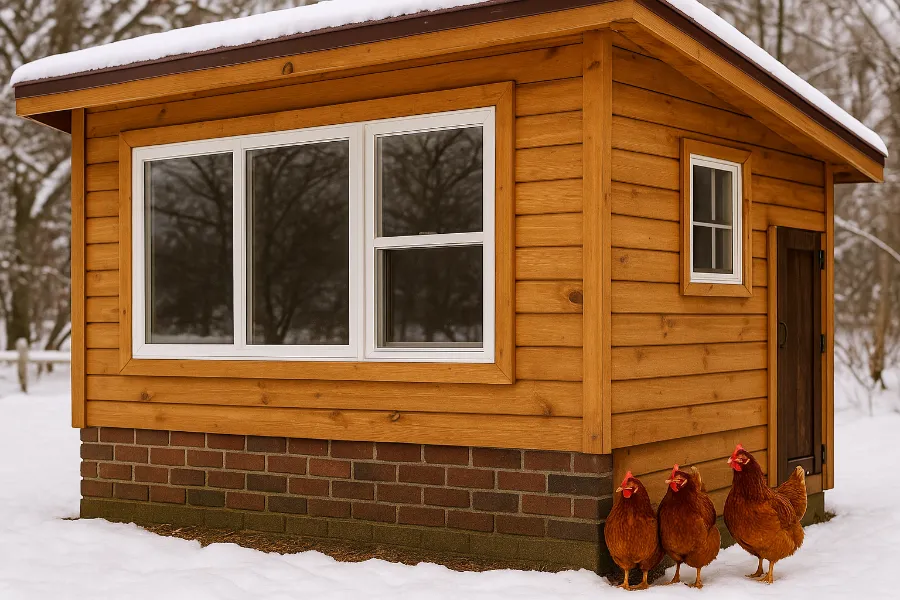
Final Thoughts: How to Winterize a Chicken Coop Naturally
Every fall, as I button up my barn and stock the feed bins, I take a few quiet minutes to walk through my coop. I check vents, replace straw, and listen to the soft clucks of contented hens settling in for the night. That’s when I know it’s ready for winter.
Learning how to winterize a chicken coop isn’t about perfection—it’s about rhythm.
You’ll develop your own system year by year, tweaking little things until it just feels right. Whether you use the deep litter method, build a solar-heated chicken coop, or live the full off grid homesteading lifestyle, your hens will tell you when you’ve got it right: they’ll stay healthy, active, and greet you with warm eggs on even the coldest morning.
That’s the quiet reward of good winter prep—and the true joy of keeping chickens through every season.
FAQs
Start by sealing drafts, adding insulation, and ensuring proper ventilation. Use dry bedding and the deep litter method to retain warmth naturally.
No, healthy adult chickens don’t need extra heat if the coop is dry and draft-free. Their body heat and proper insulation keep them comfortable.
Most cold-hardy breeds can handle temperatures down to 15°F (-9°C). Moisture and drafts are more dangerous than the cold itself.
It’s a natural heating and composting system where bedding layers decompose over time, releasing gentle warmth and improving coop hygiene.
Keep humidity low with good ventilation and dry bedding. Apply a thin layer of balm or oil to combs and wattles before freezing weather.
Breeds like Buff Orpingtons, Wyandottes, Australorps, and Plymouth Rocks are ideal for cold climates and continue laying through winter.
Add straw bale windbreaks, south-facing windows, and thermal mass like bricks or rocks. These help retain natural warmth without electricity.

